By Larry Alton
When was the last time you went to a physical retail store to buy something? As of the first quarter of 2016, according to a report by the Wall Street Journal, consumers now spend more money online than in physical retail locations, and the trend of growth in online purchases is projected to continue for the next several years.
The Fall of Brick-and-Mortar Businesses?
Does that mean retail locations are going to die out?
Not necessarily. In fact, it seems pretty unlikely. Despite the convenience and growing popularity of online retail, brick-and-mortar businesses still have the advantage of being able to offer consumers a physical, “real” experience, whether that’s as a retail store, a restaurant, a bar, or a café. If you can give customers a memorable, pleasant experience, they’ll choose you over the online equivalent every time. But what makes for a comfortable, memorable experience?
Strategies for Better Consumer Experiences
Here’s how you can make your brick-and-mortar business definitively better than an online shopping experience:
- Set the right temperature. According to LennoxPros, “temperature has a huge effect on your mood, productivity, and even how you move. Get a good HVAC system and make sure your customers are comfortable, no matter what the season is.” Some businesses, like movie theaters and cafes, do better with lower temperatures, while seasonal effects like heavy snowfall and freezing temperatures could necessitate a warmer experience.
- Use appropriate lighting. According to Mihaly Bartha of GPStudio, “Lighting has a direct influence on our mood, with 80% of the sensory information the brain receives coming from our eyes. Lighting highlights architectural elements, product qualities and creates virtual spaces – impacting how we feel, what we think of a product, and ultimately the choice of whether to purchase or not.” It also provides an atmospheric element; for example, a bar could seem more intimate and alluring with dimmer lighting.
- Carefully consider your layout. The layout of your store will guide consumers in specific ways; for example, if you structure your aisles deliberately, you could force your customers to walk the longest path around your store before they get to the checkout area, letting them see more of your inventory. You could also emphasize certain deals or specialty items by putting them more prominently in the front of your store, or in more visible locations.
- Make your branding visible. If you want your customers to associate the experience with your brand, specifically, make sure your branding is visible and prominent throughout your store, and if there are any signature qualities of your brand, make sure they’re evident throughout the customer’s experience. For example, if you want to be known for your playful personality, include more colorful and creative art on the walls, or make your store layout intentionally off-kilter.
- Employ helpful and energetic staff. According to Zeynep Ton of the Harvard Business Review, “many retailers see labor as a cost driver rather than a sales driver and therefore focus on minimizing its costs.” Your staff are responsible for giving customers the human element of their retail experience. How they’re trained, how they act, and how they interact with customers will play a massive role in your customers’ overall impressions. Hire the right people, and work hard to retain attentive, enthusiastic staff members—in all positions. You’ll attract and retain far more customers in the long run.
- Differentiate yourself from the competition. Finally, make sure to distinguish yourself from the competition. You need to give your customers a unique and memorable experience if you want them to come back, and that means standing out from the crowd. Don’t blindly follow what your competitors are doing—instead, opt for something more that defines you exclusively.
There isn’t any one right or wrong way to set up a business. There are millions of potential customers out there, covering hundreds of demographics, and all of them have different preferences you can cater to. The key is to find a combination of environmental conditions that works best for your target audience, specifically, and keep improving until you have an “ideal” setup that your customers won’t be able to forget.
Larry Alton is an independent business consultant specializing in social media trends, business, and entrepreneurship. Follow him on Twitter and LinkedIn.







